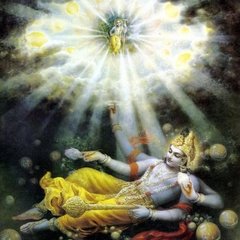Search the Community
Showing results for tags 'Advaita'.
Found 72 results
-
A by the book explanation and experiment in Kundalini Yoga. Swami T was a student of Swami Dayananda, and also a well versed practitioner of meditation. He is an Advaita Vedanta teacher. Here, he examined the source materials in Sanskrit related to kundalini yoga and tries it out for several weeks. Interesting takes on the subject. He explains what is and what is not in the ancient source material and outlines a basic practice model.
-
This explains the process in which the One appears as the many
-

Bhoothanatha Geetha of Sabarimala Ayyappan (Manikantan) - An Ancient Scripture on Advaita Vedanta
Shanmugam posted a topic in Hindu Discussion
Bhoothanatha Geetha of Sabarimala Ayyappan is a text similar to Bhagavad Gita which has 132 slokas and 8 chapters. It is a conversation between Manikantan, the prince and Rajasekaran, the king of Pandalam in which Manikantan explains the secrets of Advaita Vedanta and the ways to attain Jeevan Mukti to Rajasekeran. This text is not well known as much as the other Gitas, like Bhagavad Gita, Ashtavakra Gita, Avadhuta Gita etc. But the text beautifully summarizes the essence of spiritual wisdom in simple Sanskrit. In the following video, I have given a short introduction, explained the meaning of an important sloka in the text and also explained some other interesting details about the text: https://www.youtube.com/watch?v=kFWdynSAXfM-
- 2
-

-
- advaita
- nonduality
-
(and 1 more)
Tagged with:
-
The above popped up in my morning perusals, so sharing
-
- advaita
- nisargadatta
-
(and 1 more)
Tagged with:
-
Agamas "This is the Direct Awareness of the Self, Graciously expounded to Guha by Ishvara Himself [Shiva], The foremost and first Lord, Seated as the Self in my heart." ~Ramana Maharshi --------------------------------- Witnessing of the Atman "Atma Sakshatkara means, "witnessing of the Atman", or Self-realization, and is the name of the chapter within the jnana pada(knowledge section) of the Sarvajnanottara Agama, an obscure Upagama(subsidiary Agama) text. The sublime non-dual teaching of this text is in the form of a dialogue between Shiva and Guha(Kartikeya Murugan) where Lord Shiva is the Supreme Guru and Guha is the Disciple. The text was discovered by Sri Ramana Maharshi, who translated the chapter titled Atma Sakshatkara into Tamil sometime in the early 20th century, and also composed the introductory benediction verse. The English translation of that chapter is translated by Dr. H. Ramamurthy."
-
-
- 2
-

-
- advaita
- siddharameshwar
-
(and 6 more)
Tagged with:
-
Key pointers for meditation extracted from this series of Q&A's. https://realization.org/p/annamalai-swami/annamalai.talks.html The simplicity of how the Swami expresses the nature of this practice is gold. And for my brethren of a more Buddhist persuasion, that particular YouTube channel is a veritable gold mine. Jewels upon jewels, diamonds in the rough.
- 17 replies
-
- 1
-

-
- direct pointers
- self-inquiry
-
(and 6 more)
Tagged with:
-

The role of knowledge in spirituality and the destruction of the mind
dwai posted a topic in Hindu Discussion
Most of us here have a practical background, having spent many years in the practice of a meditative method or art (e.g., qigong, yoga, taijiquan, etc). It is true that having a practice is essential for growth and learning. And yet, many seem to gloss over the role of knowledge. There are two kinds of knowledge -- one that is taught to us by another (such as a teacher, friend or some other medium -- book, etc). Let us call this "external knowledge" or "indirect knowledge". The other is the knowledge that is directly known -- usually as a result of a regular and diligent practice of the method of our choice. Let us call this "internal knowledge" or "direct knowledge". I've seen many practitioners of spiritual arts scoff at the external knowledge because it is considered somehow inferior to the "directly" known, internal knowledge that is supposed to be the fruit of our (glorious/valiant/heroic/add your own adjective here) efforts. And yet, we would not have embarked upon the path of our choice if we didn't have an external source of knowledge to guide us throughout our journey. It is quite possible that some people, due to their karmic influence are easily able to enter into deep meditative states. But that may not result in full awakening, without proper initiation into the external knowledge. The reason being, when the deep meditative states (samādhi) are entered, there is no mind involved (or minimal mind is involved). While repeated immersion into these deep states can result in thinning of the modifications of the mind, the mind still remains functional once one exits from such states. In the vedantic tradition, the entry into samadhi is called "mano laya" (or pausing of the mind). This is considered an intermediate stage of spiritual evolution. Once the practitioner exits from the samadhi, the mind resumes its functioning (perhaps with not as much vim and vigor as it did prior, but it generally tends to gather steam and pick up from where it left off eventually). The only way to cause what in vedanta is called "mano nāsha" (mind cessation) is to deliberately and methodically work with the external knowledge (as taught by the teachers and texts) and go through a process of intellectual assimilation. The mind has four components, namely the ego, the thought field, the storehouse of memories and impression and the intellect. For knowledge to be integrated, it has to be worked on with the cooperation of the mind (ego-thought field-storehouse-intellect). Key among them is the intellect. Whatever the intellect identifies with, the ego will do its level best to protect/maintain that. If the intellect identifies with the body, the ego will strive to maintain that identification. If the intellect identifies with the mind, ego will strive to maintain that identification. Therefore, the intellect needs to come onboard with the process of spiritual development. Once the intellect is onboard, all the other components of the mind will follow its lead. So with the study and contemplation on the external knowledge using the intellect, the intellect needs to be convinced of its 'place' in the grand scheme of things. When the intellect understands completely that it is merely a function of the mind, and that the mind is nothing but a process arising in awareness, the intellect will gradually relinquish its need to identify with anything. It might initially start by giving up identification with the body and the mind. Typically the intellect latches onto the idea of being "The Non-dual Self/Awareness". And it is a far better proposition that being identified with the body/mind. Then the seeker wants to constantly abide in this "non-dual awareness". Of course, life usually has other plans, so the feeling of non-duality, and the feeling of duality keep coming and going, oscillating between the two phases at regular intervals. This leads to great frustration in the intellect of the practitioner. And then one day the realization occurs, that what we truly are, is aware of both the duality and non-duality that seems to arise in the mind. And on that day, the intellect gives up completely, and the ego disappears, as it has nothing to defend anymore. This results in a fully non-grasping mind, essentially a mind that has ceased to operate as it used to before spiritual practice started. And therein is the direct knowledge or internal knowledge, which is nothing but that which is aware of both the apparent duality and non-duality.- 3 replies
-
- 8
-

-

-
- nonduality
- advaita
- (and 4 more)
-
The Sun never fails to amaze, inspire and awe us — the giver of life, light and warmth. And like the outer Sun, the inner sun — Atman, the Self is amazing — without it, there would be no Sun, Earth or in-fact the Entire Universe. http://www.kamakoti.org/shlokas/#gsc.tab=0
-
-
This one upanishad is adequate for spiritual awakening. May you awaken right now It’s very ‘cool’ to want exotic and mystical experiences. I’ve had many. But these are still experiences. When you realize who you truly are, reality stands revealed as it is — we can find the infinite and self-luminous One (Tadekam) in and shining forth through the infinite phenomena that make up the universe itself.
-
A wonderful discussion by Swami Sarvapriyananda on the topic of why many people don’t get/realize the nondual teachings easily. And what should one do if direct nondual pointers don’t work for you.
-
- 65 replies
-
- 6
-

-

-
A question that I’ve asked and others I know also have — in fact it is a frequent question in the process of nidhidhyāsanam (Advaita Vedantic practice/meditation) : “How can I stay constantly aware of my True Nature?” Swami Sarvapriyananda answers beautifully —
-
In Advaita Vedanta study, there are three steps. They are somewhat sequential but also overlap after the initial introductory period. They are - shravanam - listening to the teaching mananam - contemplation on the teaching nidhidhyasana - meditation, but really constantly working on separating the real (true nature) from unreal (apparent reality), until one is stable in their recognition of their Self as the nondual awareness initially after we learn the teachings and begin to understand it, we have the urge to constantly remember who we truly are (I know I’ve referred to this as “constant remembrance”)... But therein lies a mistake that ( in retrospect) can be avoided. Just like we don’t need to keep telling ourselves we have eyes, in that the fact is self evident with the act of seeing; similarly we don’t have to keep telling our selves that we ARE awareness, as the act of being/knowing itself makes that a self-evident fact. This is a subtle realization that happens once we realize that we are neither the body, nor the mind, and that the circumstances of our lives do not affect our inherent ground nature. The ups and downs of life can affect the mind, the body and even the circumstances in which the mind and body exists. However, that which knows the changing states of the mind, body and circumstances is totally unaffected by those changes. It is then that the need for constant remembrance can be dropped - which is in essence a subtle clinging to the idea of Being The Self (or Self realization). Swami Sarvapriyananda puts it beautifully here —
-
A very interesting promise is made by Advaita Vedanta -- This might seem very silly to most people, but this promise is very profound and has great depth to it. What does "attain what you already have" mean? It means you are already Brahman/Atman. There is really nothing to attain per se. The attainment is merely a dropping of the veil that seemed to hide your true nature. After the veil drops, you realize you were already and always that which you realized What does "give up what is not yours anyway" mean? It means the world of objective reality, where you are a doer of actions and owner/possessor of things becomes apparent as just an appearance. So you give up the idea of being a doer and possessor, because you never were a separate actor or owner of "things". They were just appearances that rose and dissipated in you, the reality.
-

Advaita Vedanta and Kungfu - An Article by Huai Hsiang Wang
dwai posted a topic in General Discussion
-
-
-
From the Vidya Gita, which is part Tripura Rahasya. Enjoy the enlightenment
-
This video is excellent as it gives a very pragmatic approach to taking Advaita Vedanta knowledge into our daily lives. Interestingly, it clarifies a lot of misconceptions about AV (often demonstrated on daobums as well ). If you want to *really* hear about AV from a genuine master’s mouth, please watch this (and other videos too) video lecture by Swami Sarvapriyananda.
-
-
- swami vivekananda
- advaita
-
(and 1 more)
Tagged with:



